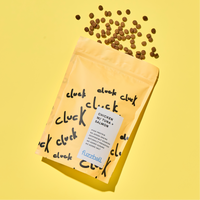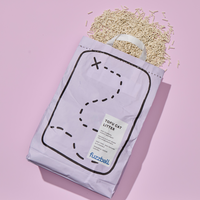How to Travel With Cat Food Without Compromising Quality

It can be fun and hard to travel with your cat. There are a lot of things to think about, like where to stay that is pet-friendly and how to keep your cat comfortable on the trip. But one thing that a lot of cat owners don't think about is how to safely travel with cat food without ruining its freshness, nutritional value or your cat's health.
It's very important to keep your cat's diet the same, whether you're going on a weekend trip or a long road trip across the country. This guide has everything you need to know about travelling with cat food, like how to pack it, how to store it and a full comparison of the different kinds of travel food.
Why It's Important To Have Good Food When You Travel With Cats
Cats are creatures of habit. If you suddenly change their diet or the quality of their food, it can upset their stomach, stress them out or even make them refuse to eat. Also, heat, humidity or air can ruin cat food, especially wet or raw kinds, which can cause it to spoil or lose nutrients.
Your cat's immune system might already be a little stressed out from being in a new place when you travel. Giving your cat bad or spoiled food could make that stress worse and make them sick. That's why keeping food safe is not just about making things easier; it's also about your cat's health and comfort.

How Can Pet Owners Ensure Quality is Not Compromised When Travelling?
A cat that is well-fed is calm, which makes the trip better for everyone. Keep in mind that your cat relies on you for stability. Sticking to a regular feeding schedule and giving them safe, fresh food will make the trip better for both of you.
Step 1: Plan Your Cat’s Meals Ahead
Before you pack, figure out exactly how much food your cat will need for the whole trip, plus one or two extra days' worth in case of delays or emergencies. How to calculate:
- Figure out how much food your cat should eat each day based on their usual feeding schedule.
- To get the total, multiply that by the number of days you will be travelling.
- As a safety measure, add 10–20% more food.
Step 2: Choose the Right Type of Cat Food for Travel
Some cat food doesn't travel as well as others. Some types will be easier to deal with than others, depending on how you get there and how long it takes.
Here’s a quick comparison:
|
Type of Cat Food |
Best For |
Storage Needs |
Shelf Life |
Travel Pros |
Travel Cons |
|
Dry Kibble |
Road trips, flights, and long travel |
Cool, dry place |
6–12 months |
Lightweight, easy to store, no refrigeration |
May get stale if not sealed properly |
|
Canned Wet Food |
Short trips or hotel stays |
Room temp before opening; refrigerate after |
2–5 years unopened |
Palatable, high moisture |
Heavy, bulky, and needs refrigeration once opened |
|
Dehydrated/Freeze-Dried |
Camping, hiking, extended travel |
Airtight bag |
1–2 years |
Lightweight, retains nutrients, easy to rehydrate |
Needs clean water to prepare |
|
Raw Food |
Only for short trips (if refrigeration is available) |
Constant refrigeration |
1–3 days |
Highly nutritious |
Spoils fast, hard to manage |
|
Pouches/Single-Serve Wet Packs |
Flights, car trips |
Room temp before opening |
1–2 years unopened |
Convenient, minimal mess |
Costly, requires disposal after use |
Step 3: Keep Food Fresh and Safe
When cat food is exposed to heat, sunlight or air, it can go bad quickly. This is how to keep things fresh:
For dry food:
- Use containers that don't let air in. Plastic or stainless steel that doesn't contain BPA is best.
- If you can, vacuum seal it to keep it fresh and tasty.
- Keep it out of direct sunlight and car heat and in a cool, dark place.
- Don't use tape or clips to reseal bags because they don't completely block air.
For wet or raw food:
- Use insulated cooler bags with ice packs or small, portable coolers.
- Before you leave, freeze the portions overnight. This will keep them fresh longer.
- Don't ever leave food in a car that is hot. Temperatures can rise quickly enough to ruin food.
- Make sure to check the expiration dates and keep new cans or pouches separate from open ones.
For food that has been dehydrated or freeze-dried:
- Keep it in its original packaging until you need it. Most of these packages are made to keep moisture out.
- Use clean bottled water when rehydrating during travel.
Step 4: Bring Feeding Essentials
These things will help you have a smooth meal on the go:
- Lightweight and easy to clean, collapsible bowls for food and water.
- Scoops for measuring out portions.
- A towel or placemat to prevent messes
- Portable water bottle—water is just as important as food.
- Trash bags or wipes make it easy to clean up.
A small travel feeding kit in a zippered bag can also help you keep everything in order.
Step 5: Stick To Your Routine While Travelling
Cats like to have a set schedule. Even when you're on the road, try to feed your cat at the same times you do at home. Changes in feeding times that happen all of a sudden can make people anxious or upset their stomachs.
If you have to drive for a long time, plan stops that fit with when you need to eat. Check the rules of your airline if you're flying with your cat. You might have to feed it before you leave and after you land instead of during the flight.
Step 6: Staying Hydrated Is Very Important
When cats travel, they are more likely to get dehydrated, especially if they are nervous or in dry places. To keep your cat hydrated, give them fresh water often. If your cat doesn't drink enough, bring bottled or filtered water from home and mix it with dry kibble. If your cat is used to wet food, switching to dry kibble for travel can make them more likely to get dehydrated. To make up for this, give them more water.
Step 7: Store Food Properly Upon Arrival
When you get to your destination, put dry food in a cool, airtight container that isn't in direct sunlight. Always keep cans of wet food that are open in the fridge and covered. If you're going to be there for a while, get a mini-fridge or ask your hotel for one.
Before you travel to another country, always check the rules for bringing pet food into that country. Some countries don't allow raw or meat-based foods.

Bonus Tips: What to Avoid
- Don't switch brands all of a sudden; this could upset your cat's stomach.
- Don't feed your dog leftover human food while you're on the road.
- Never leave food out in open containers for a long time.
- You shouldn't only buy pet food from convenience stores because the ingredients or quality may be different.





